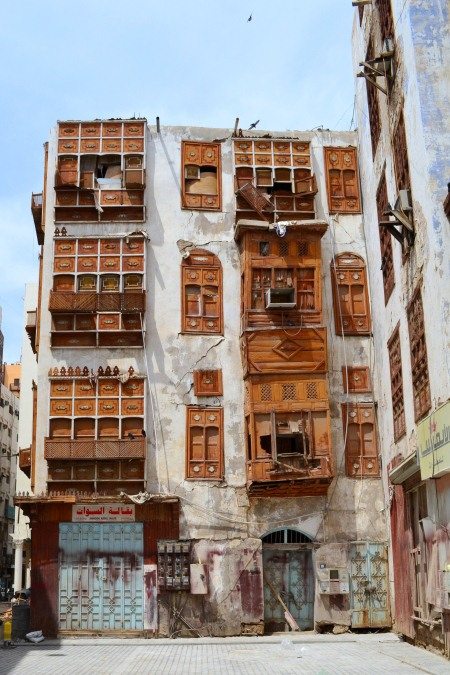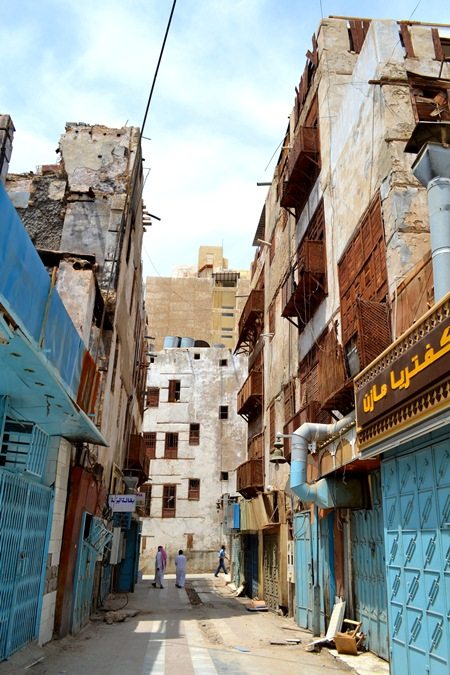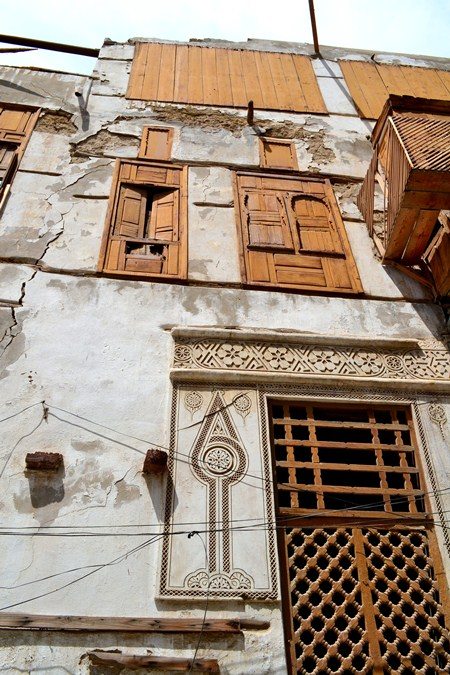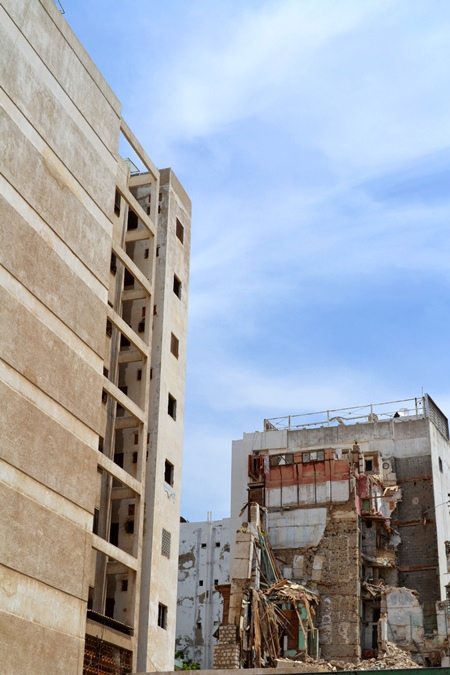The heart of Jeddah
Old Jeddah, known by the name Al Balad, is the historical region of Jeddah, stretching over an area of one square kilometre within the city walls. Six to seven hundred homes, some of which date 500 years back, make up Al Balad.

There are four main neighbourhoods in Al Balad:
The Al-Sham (The Damascus) neighbourhood in the northern part inside the city walls. (in green on the map)
The Al-Yemen neighbourhood in the southern part inside the city walls. (in yellow)
The Al-Mazloum (The Persecuted) neighbourhood in the eastern part inside the walls. (in blue)
The Al-Baher (The Sea) neighbourhood in the western part, overlooking the sea. (in red)
The historical city is a warren of tiny streets, each with a name that tells its story. Al-Attarin Street [The Perfumers’ Street] is where perfumes are sold. Al-Leyat Street is famous for producing shisha hoses. Some of these lanes, such as Ohdoni [Hug Me] street no longer exist, however. Ohdoni was extremely narrow to the extent that only one person at a time could pass through it. If two people ever had to cross paths in Ohdoni Street, they had to stick close to each other, almost hugging one another, in order to be able to pass.
Countless stories were recounted about Al-Mazloum neighbourhood. The legend has it that a man was executed here in 1131 AH [corresponding to 1719 AD]. This was never proven. According to the story, his blood flowed out on the sand forming the word “innocent”. Ever since, the story has been the symbol of the neighbourhood.

A place where the rawashin rules
The houses in old Jeddah are characterised by a traditional architectural style, and marble is at the core of every edifice. With their embedded Indian and Javanese teak beams, these tall buildings are absolutely fascinating. This type of wood catches the breeze, providing good ventilation in the homes. It also gives a nice shade, which is much appreciated by people walking down the narrow streets.
Traditionally, Jeddah’s old houses are four or five stories high with large windows, which stretch from the ground to the roof in grey wooden planks. In old Jeddah, the use of glass was not common. Instead, those beautifully designed carved grilles, called rawashin, were placed on the external windows.
Doors were commonly made of two large heavy teak wood boards, decorated with delicate carvings deeply etched, with precious hinges and metal hammers that were fastened to them. Holes or small windows were also craved in the middle of the gigantic door to serve as peepholes.

Failed attempt to register Al Balad to the UNESCO
Saudi Arabia recently withdrew its application for registering Jeddah’s Al Balad as a UNESCO World Heritage Area, something that wryly dominated the headlines of the country’s newspapers.
The reason was the many damages that have been caused to Al Balad in recent years as a result of, on the one hand, climatic factors such as soil erosion and rain, and on the other, negligence and slow measures of renovation.
Reviving the heart of Jeddah
Currently, the UNESCO application is the most recent initiative to reconstruct and restore the neighbourhood. However, according to architect Ziad Aazam, the road of initiatives started 15 years ago with Dr. Sami Angawi. Mr. Angawi has established his own office, under the name of Lamar, in Al Balad, in an attempt to revive the region.
In the same context, architect Abdul Aziz Kamel, who passed away, was working with Dr. Hisham Gomaa to set up a company named The Centre of Jeddah as an initiative to revitalise and restore Al Balad. The idea was to work in a similar way to that of Solidere, the Lebanese company in charge of rebuilding Beirut’s post-war city centre. Many criticise the company for taking the monopoly of all of downtown Beirut district as well as the result of the reconstruction of the neighbourhood, deemed to be very artificial.
Solidere was even assigned to take over the management of the project in Al Balad. Fortunately, the project was not meant to see light of day. Otherwise, the neighbourhood would have been swarmed with cafes, offices and restaurants. The spirit of Al Balad would have been lost forever.

Al Balad transformed like downtown Beirut?
Some thoughtless entrepreneurs suggest to backfill the entire area in order to invest in the land, ignoring its historical, social and cultural dimensions.
To make matters worse, the investors do not make their true intentions regarding their projects in the area clear, for fear of the reactions of those defending Al Balad’s historical value. This leads to a constant fear of deceit. Still, these investors cannot evict anyone from their houses, which are generally inherited. They have the right to keep their belonging. Some are more vulnerable though than others, like some elderly women living by themselves, with no support or family.
Dr. Aazam stresses that the biggest problem facing Al Balad is the lack of a balance in adopting social, cultural and economic aspects of this historical area. The focus has increasingly shifted to economic dimension and short-term personal benefits only, regardless of the advantages that a renovated and revived Al-Balad would bring to Jeddah. This is a matter for the city’s authorities, who ought to issue laws preventing the establishment of projects with personal benefits.
Mobilising to save the old city
The Saudi government has put forth a good initiative, managed by the Jeddah Urban Development Company and SCTA. Several significant studies have been put released and the area has been surveyed on what services are available for the residents. But, much due to the absence of a strong civil society in Al-Balad, the problem persists. Dr. Aazam has been trying to counter this through organising regular Al-Balad trips within the framework of his project, Jeddah’s Heart, shedding light on the historical value and importance of the old city.
Jeddah is a unique place. A number of overlapping economic, religious and social factors – most importantly, the city’s proximity to the holy city of Mecca – has created a vibrant cultural and ethnic mosaic. The spirit of the old city cannot be saved by renovation projects or new buildings. Instead, people ought to mobilise and raise their voices to revive this historical area. Only then, Al Balad would live on.
This map was made by Muhammed Shukri from the group Jeddah’s Heart. It is the first map of Al Balad, with valuable information of the owners of the houses, created by the people for the people. It is the first draft. The information was gathered from Omdah Malak in Al Balad, from Jeddah’s municipality (information from Ziad Aazam).
Edits and translation by Sahar Ghoussoub
Correction: In a previous version of the article, we erroneously called the rawashin, musharabiya a word used in other countries. We thank our reader Ebti for pointing that out.
5 thoughts on “The heart of Jeddah”
Comments are closed.







nice artikel!I like allo tjat it is written in tio languages so you can practise the languages.
Thank you
Annika Noori
Thanks for featuring Jeddah. One tiny correction, المشربيات is the Egyptian word, in Jeddah we call it Rawashin (plural)& Roshan (singular)we even have a mall called Roshan http://www.shayaa.net/ar/shows/roshan-ma.jpg.